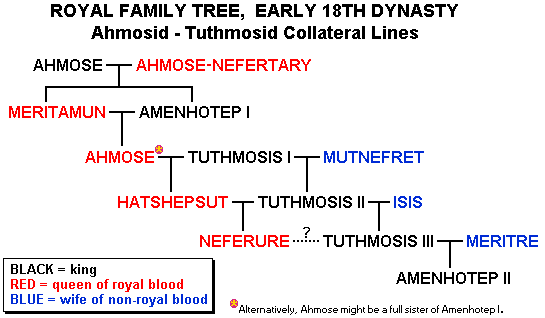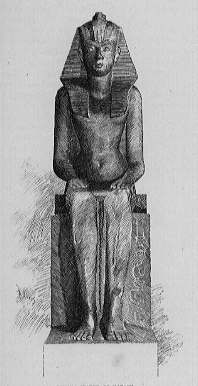
1473-1458 BC - 18th Dynasty
Hatshepsut, of the 18th dynasty, was one of the few female pharaohs of Egypt. Although there were female pharaohs prior to her and after her, Hatshepsut was extraordinarily special. Although men dominated society, women in Egypt had an advantage over women in other societies. They were allowed to own property, to hold official positions, and to inherit from their parents or late husbands and she was aloud to take her case to court to defend her legal rights.
Hatshepsut had some help in dominating society. Due to Egypt's "looseness" in allowing women significant amount of freedom and legal rights, especially compared to women in other ancient societies, help make it possible for a number of queens, prior and after Hatshepsut, to gain some influence over the kingdom of Egypt as regents. The 17th Dynasty had numerous important and influential queens. Ahmose-Nefertary, Tetisheri and Ahhotep IIwere all had some control over the government of Egypt. Because they succeeded each other, they had an important impact on the general view of women, and were able to maintain stability and order. This led the way for Hatshepsut to become the most extraordinary female to hold the title of Pharaoh in ancient Egypt.
Hatshepsut was the daughter of Pharaoh Thutmose I (a commoner and 3rd ruler of the 18th Dynasty) and Queen Ahmoes Nefertari. She was born in 1503 BCE (Before Common Era). Hatshepsut received her sovereign rights by right of maternal descent from the 12th Dynasty Queen Nefertari (Neferteti), who supposedly was the true daughter of the god Amun.
~ Thutmose was able to rule because his wife was a descendant of the god and it had become tradition that one could only rule Egypt if they were the descendant of Ra or Amun or if they were married to one. It was the Queens and Princess who carried the right of.~
Hatshepsut was not originally the Heiress-Princess but became so when her three older siblings died: her brothers, Wadjmose and Amenmose and her sister, Neferuity. There are many conflicting stories as to when Hatshepsut began her rule, one (that I choose to believe) is that she ruled as Queen and Queen-Regent while her father was still alive. Perhaps as a way to teach Hatshepsut the ways of governing rather quickly. You must remember that all Hatshepsut had been taught, up till her sibling's deaths, was how to be a "good" wife. With her older sibling's death, Hatshepsut had to be brought up to speed on what was going on in court. Many have taken it that Pharaoh Thutmose favored Hatshepsut over his son, Hatshepsut's stepbrother. Generally, history agrees that Thutmose II was a less then good leader and that it was only natural for someone to take over, it repeats constantly in history. Although most probably didn't expect Hatshepsut to take over as well as she did, but then they also forget that Hatshepsut ruled for many years as her father's co-ruler before he died.
When Thutmose I died his son, Thutmose II, married his co-ruler, Hatshepsut, and succeeded him. Thutmose II had no choice in this arrangement if he wished to be Pharaoh. He had no royal blood. His mother was a foreigner and his father had been a commoner before the Pharaoh Amenhotep I (Pharaoh before him) married him to his daughter (although some say sister), who did have royal blood. At the time of Thutmose I's death, Hatshepsut was the only female Egyptian (only females can bare children and know who their offspring are) with royal blood. Thutmose II had to marry Hatshepsut. [See Family tree below]
Thutmose II and Hatshepsut had 1 daughter (some say 2, the second being Hatasu-Meri) together: Neferu-Ra (also known as Neferure). Thutmose II had one son, Thutmose II, by the concubine Isis. When Thutmose III was still an infant and Hatasu-Meri barely older than a toddler, Thutmose II died, possibly in the year 1479 or 1504 BCE. Hatasu-Meri and Thutmose III were married or betrothed and Hatshepsut became Thutmose's regent.
This is where some confusion comes in. Hatshepsut ruled as Queen and Queen-Regent while her father was still alive, then she ruled as Thutmose II's Queen for a dozen or so years, until Thutmose II's death. And here is the conflict: whether Hatshepsut proclaimed herself Pharaoh right after Thutmose II's death or waited. Many say she named herself Regent - of her young nephew-son, Thutmose III and then proclaimed herself Pharaoh. Others say she went straight to the title of Pharaoh and ruled as such for approximately 15 years. Hatshepsut's total reign was somewhere around 34 years.
This is where the diffrent theories divide a little. Hatshepsut, supposedly, named Hatasu-Meri "Heiress-Princess," as the Queen herself was once called. She may have done this to excluded Thutmose III from the order of succession, a kind of switch in the traditional roles: Hatasu-Meri would rule and Thutmoses would be an ornament, a trophy-husband if you will, with no real political power. Perhaps Hatshepsut meant to start a Dynasty of women rulers, however, there is no proof to this. But the theories involving Hatasu-Meri all have her dying and thus ending Hatshepsut's supposed dream of a women-only dynasty. Neferu was married to Thutmose III. Some feel Neferu was married so that Hatshepsut wouldn't appear to be a usurper. Others, because Neferu was spoiled rotten as the younger sibling and had no talent at politics.
At any rate, Thutmose II died, possibly in the year of 1479 BC, (2) and Thutmose III became Pharaoh. With Thutmose III being a minor at this time, his aunt, Hatshepsut, stepped in as his regent. Thutmose III and Hatshepsut ruled together until 1473 BC, when she appointed herself Pharaoh. After her death, or exile, Thutmoses II ruled for approximately 30 years before he/his followers desicrated Hatshepsut's temples and images. Perhaps Neferu or Isis the concubine were calming influences in Thutmoses' life and they had died, thus leaving a path for Thutmoses to act out his anger at his step-mother/aunt. Who knows for sure?

18th Dynasty Family Tree http://www.library.nwu.edu/class/history/B94/18dynfam.gif
Statue of Hatshepsut as a Pharaoh.

Everything on my sites is either mine or used from somewhere else with the thought that it was okay to be used on this non-comercial site. If this isn't true email me and I'll fix it. I've provided links to the sites where I got some of my information and pictures. If I missed something, email me and I'll fix it.
![]()
Please email me with comments at: Makara@Bastet.i-p.com